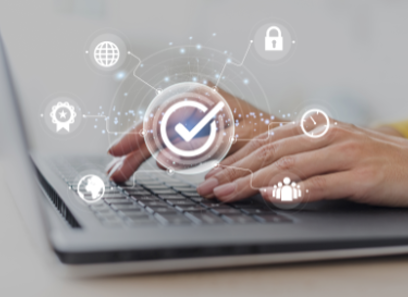Future-Proof Your Service: Trick Cybersecurity Predictions You Need to Know
As companies confront the accelerating pace of electronic makeover, comprehending the advancing landscape of cybersecurity is crucial for long-term resilience. Predictions recommend a substantial uptick in AI-driven cyber hazards, alongside heightened regulatory scrutiny and the crucial shift towards Zero Trust Design. To effectively browse these difficulties, companies should reassess their safety and security techniques and cultivate a culture of recognition amongst workers. The ramifications of these modifications prolong beyond simple compliance; they can redefine the extremely framework of your functional protection. What actions should companies require to not only adjust however flourish in this brand-new atmosphere?
Increase of AI-Driven Cyber Threats

Among one of the most concerning growths is the use of AI in producing deepfakes and phishing plans that are extremely convincing. Cybercriminals can make sound and video clip material, posing execs or relied on people, to adjust targets right into divulging sensitive details or authorizing fraudulent purchases. Furthermore, AI-driven malware can adapt in real-time to evade discovery by typical safety procedures.
Organizations have to recognize the urgent demand to bolster their cybersecurity frameworks to combat these developing risks. This includes investing in advanced threat detection systems, promoting a society of cybersecurity recognition, and implementing robust event response strategies. As the landscape of cyber hazards changes, positive procedures end up being vital for securing sensitive information and keeping service stability in a progressively digital globe.
Boosted Emphasis on Data Personal Privacy
Exactly how can organizations successfully browse the growing focus on data privacy in today's electronic landscape? As governing structures progress and consumer assumptions rise, businesses have to prioritize durable information personal privacy approaches. This includes adopting thorough data administration policies that ensure the honest handling of personal info. Organizations ought to perform routine audits to assess conformity with policies such as GDPR and CCPA, recognizing prospective vulnerabilities that can result in information breaches.
Purchasing employee training is critical, as personnel awareness directly affects data security. Organizations needs to promote a society of personal privacy, encouraging workers to comprehend the relevance of safeguarding sensitive details. In addition, leveraging innovation to enhance information security is important. Carrying out advanced encryption approaches and secure information storage space solutions can considerably alleviate threats related to unauthorized gain access to.
Partnership with lawful and IT teams is crucial to straighten information personal privacy initiatives with company goals. Organizations must likewise engage with stakeholders, consisting of customers, to communicate their commitment to information personal privacy transparently. By proactively attending to information personal privacy concerns, companies can construct trust and enhance their credibility, ultimately adding to long-term success in a progressively inspected electronic atmosphere.
The Change to Zero Trust Architecture
In response to the developing threat landscape, companies are increasingly adopting Zero Trust Style (ZTA) as a basic cybersecurity method. This method is asserted on the principle of "never ever depend on, constantly validate," which mandates constant verification of customer identifications, gadgets, and information, no matter of their place within or outside the network perimeter.
Transitioning to ZTA includes carrying out identity and accessibility administration (IAM) solutions, micro-segmentation, and least-privilege accessibility controls. By granularly managing accessibility to resources, organizations can mitigate the threat of insider hazards and lessen the impact of outside breaches. ZTA incorporates robust tracking and analytics capacities, allowing companies to detect and respond to abnormalities in real-time.

The change to ZTA is additionally sustained by the boosting adoption of cloud services and remote job, which have actually expanded the assault surface (Deepfake Social Engineering Attacks). Standard perimeter-based safety models want in this brand-new landscape, making ZTA a much more durable and adaptive structure
As cyber dangers remain to expand helpful hints in elegance, look what i found the adoption of No Count on principles will certainly be essential for companies looking for to shield their properties and keep regulative compliance while ensuring organization connection in an unpredictable environment.
Governing Modifications coming up

Upcoming regulations are anticipated to resolve a series of problems, consisting of data privacy, violation alert, and event reaction methods. The General Data Security Guideline (GDPR) in Europe has actually set a precedent, and similar structures are emerging in other regions, such as the USA with the proposed federal privacy legislations. These laws commonly enforce strict charges for non-compliance, stressing the need for organizations to prioritize their cybersecurity procedures.
In addition, industries such as financing, medical care, and critical facilities are most likely to encounter a lot more rigorous requirements, reflecting the sensitive nature of the information they take care of. Compliance will not simply be a lawful commitment yet a crucial element of building depend on with consumers and stakeholders. Organizations has to stay ahead of these changes, incorporating regulatory requirements into their cybersecurity methods to make certain resilience and protect their assets efficiently.
Relevance of Cybersecurity Training
Why is cybersecurity training a vital element of an organization's protection technique? In an era where cyber hazards are significantly advanced, organizations have to identify that their staff members are usually the initial line of protection. Effective cybersecurity training equips team with the expertise to identify possible risks, such as phishing strikes, malware, and social engineering methods.
By promoting a society of protection understanding, companies can considerably lower the risk of human mistake, which is a leading reason for information breaches. Normal training sessions guarantee that staff members stay educated investigate this site regarding the current hazards and finest techniques, consequently enhancing their capability to react properly to incidents.
In addition, cybersecurity training promotes conformity with regulatory needs, reducing the threat of legal consequences and economic penalties. It likewise encourages workers to take ownership of their function in the organization's safety framework, resulting in an aggressive instead of reactive method to cybersecurity.
Verdict
In final thought, the progressing landscape of cybersecurity demands positive actions to deal with arising hazards. The surge of AI-driven strikes, combined with heightened information personal privacy issues and the change to Absolutely no Depend on Architecture, demands a thorough technique to safety.